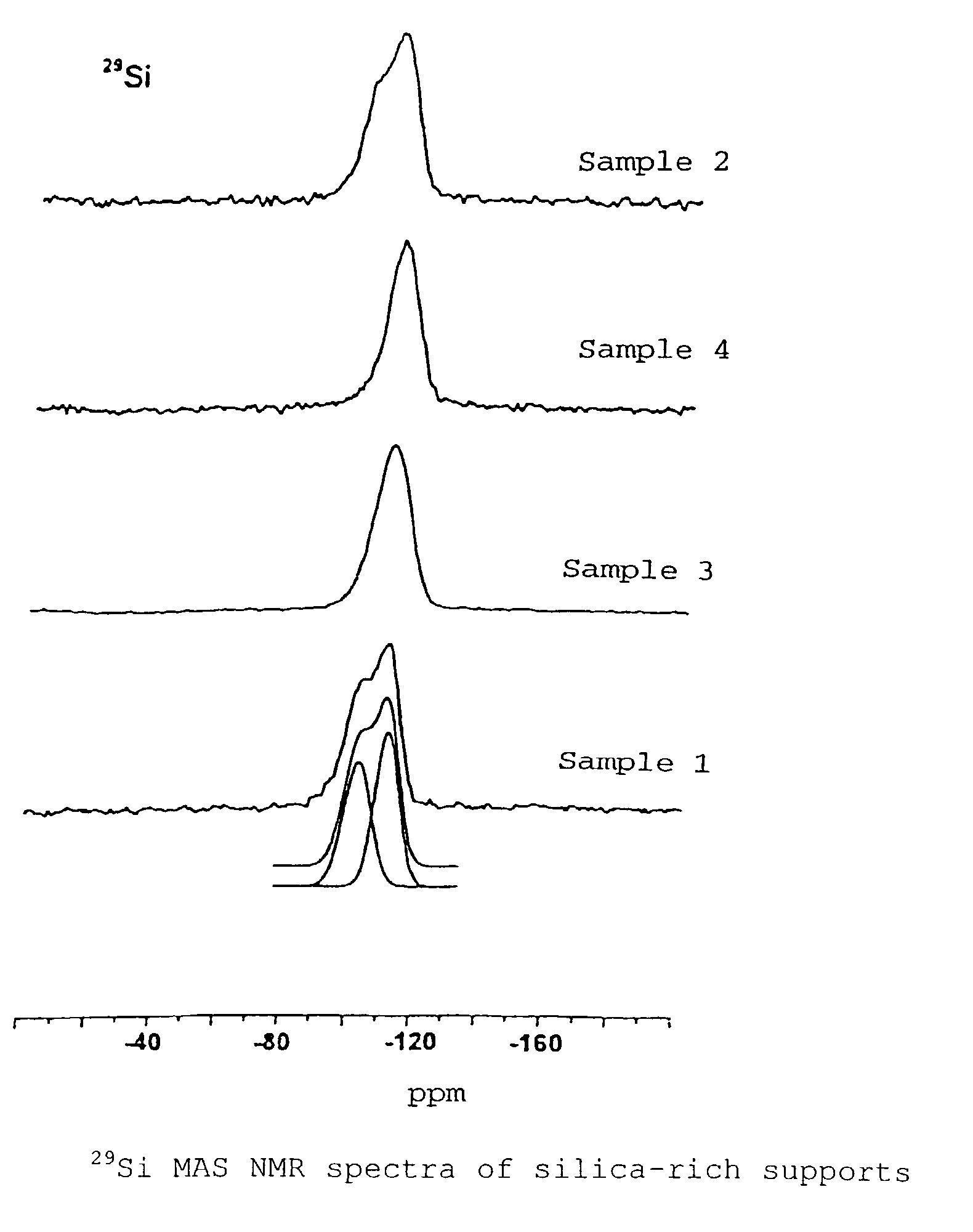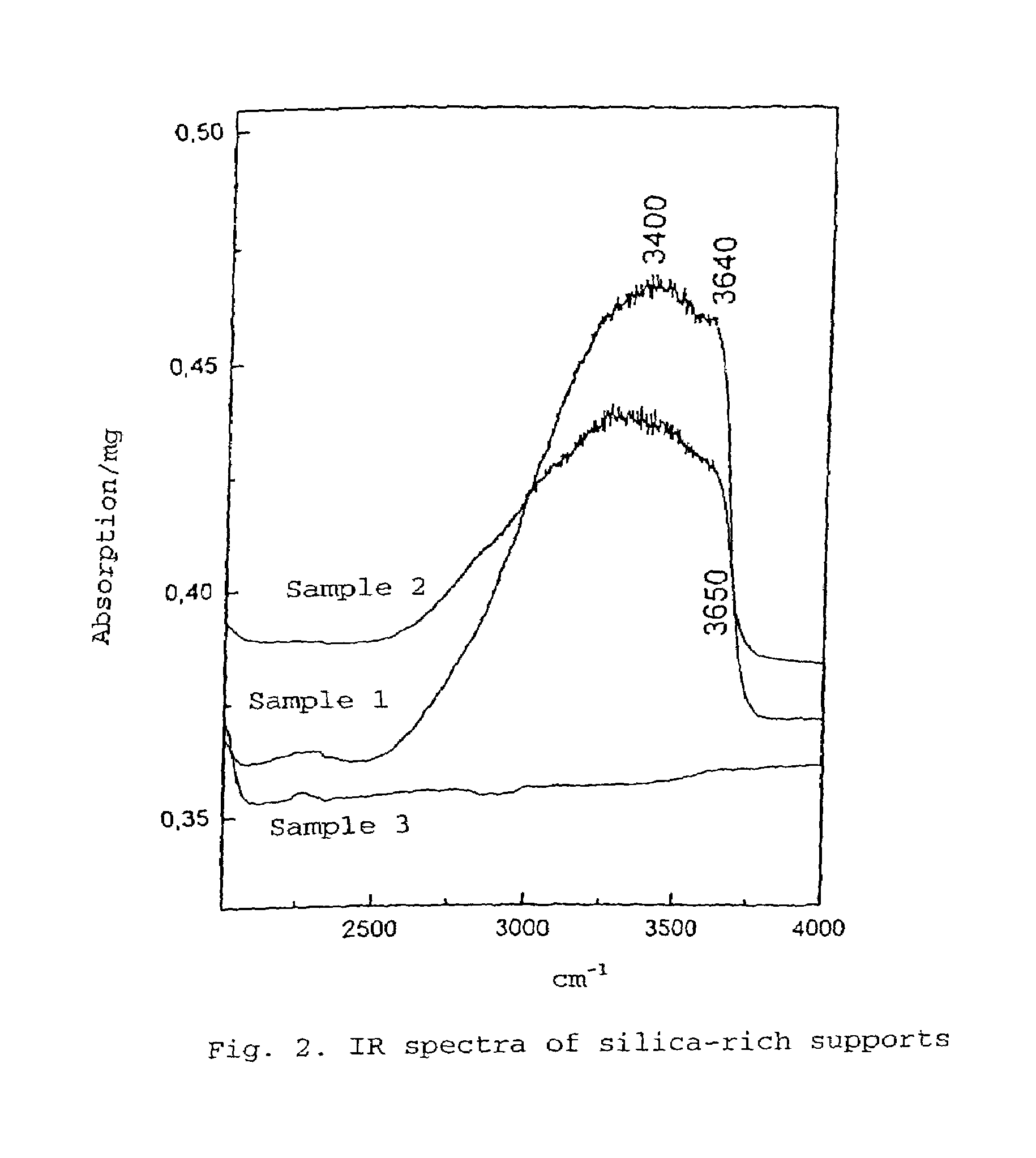Silica-rich carrier, catalyzer for heterogeneous reactions and method for the production thereof
a carrier and heterogeneous reaction technology, applied in the direction of metal/metal-oxide/metal-hydroxide catalysts, inorganic chemistry, silicates, etc., can solve the problems of reducing the effectiveness factor deu to pore diffusion restrictions, reducing the effectiveness factor, and complicating the technology of catalyst preparation
- Summary
- Abstract
- Description
- Claims
- Application Information
AI Technical Summary
Benefits of technology
Problems solved by technology
Method used
Image
Examples
example 2
[0096]To 10 g of a glass cloth support with the characteristics of Sample No. 2 (Table 1) there are added 50 ml of CsNO3 solution with the concentration of 0.5 g Cs / 100 ml, kept at 100° C. and superatmospheric pressure of 1 atmosphere for 6 hours, then washed out with a 5-fold excess of distilled water and dried in air at 20° C. for 10 hours. The resulting modified support is impregnated with a solution of (NH4)2[PtCl6] with pH=10 at t=200° C. and pressure of 14 gage atmospheres for 12 hours. Then the sample is washed with distilled water acidulated to pH=3, dried in air at 110° C., calcined in air at 200° C. for 2 hours, and reduced in a stream of hydrogen at 200° C. for 2 hours.
[0097]The catalyst contains 0.02% Pt and 0.2% Cs.
example 3
[0098]To 10 g of a glass cloth support with the characteristics of Sample No. 2 (Table 1) there are added 50 ml of a solution of [Pt(NH3)4]Cl2 with the concentration of 0.05 g Pt / 100 ml and kept at t=150° C. and superatmospheric pressure of 4 atmospheres. Then the sample is washed out with a 3-fold excess of distilled water to which ammonia is added to pH=8, dried in air at 150° C. for 10 hours, calcined in air at 350° C. for 2 hours, and reduced in a stream of hydrogen at 200° C. for 2 hours.
[0099]The catalyst contains 0.01% Pt (Table 2).
example 4
[0100]To 10 g of a glass cloth support with the characteristics of Sample No. 1 (Table 1) there are added 50 ml of a solution containing 0.8 g of PdCl2+0.1 g of CsCl+5 g of HCl and kept at t=40° C. and superatmospheric pressure of 1 atmosphere for 8 hours. Then the sample is washed out with a 5-fold excess of distilled water, dried in air at 110° C. for 10 hours, calcined in air at 200° C. for 3 hours, and reduced in hydrogen at 200° C. for 3 hours.
PUM
| Property | Measurement | Unit |
|---|---|---|
| Temperature | aaaaa | aaaaa |
| Temperature | aaaaa | aaaaa |
| Percent by mass | aaaaa | aaaaa |
Abstract
Description
Claims
Application Information
 Login to View More
Login to View More - R&D
- Intellectual Property
- Life Sciences
- Materials
- Tech Scout
- Unparalleled Data Quality
- Higher Quality Content
- 60% Fewer Hallucinations
Browse by: Latest US Patents, China's latest patents, Technical Efficacy Thesaurus, Application Domain, Technology Topic, Popular Technical Reports.
© 2025 PatSnap. All rights reserved.Legal|Privacy policy|Modern Slavery Act Transparency Statement|Sitemap|About US| Contact US: help@patsnap.com



